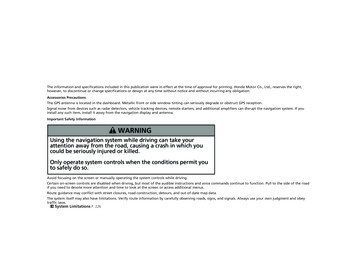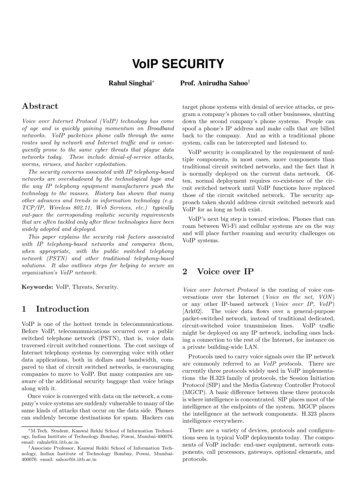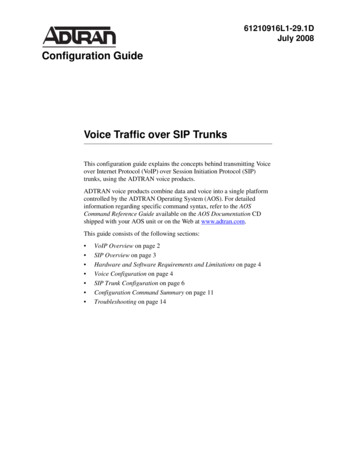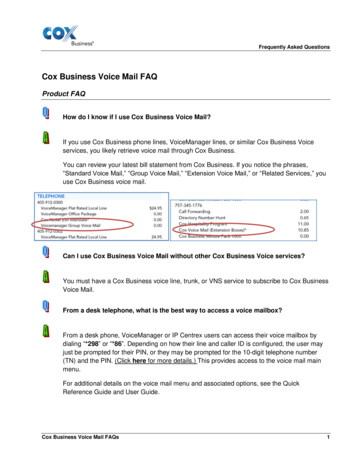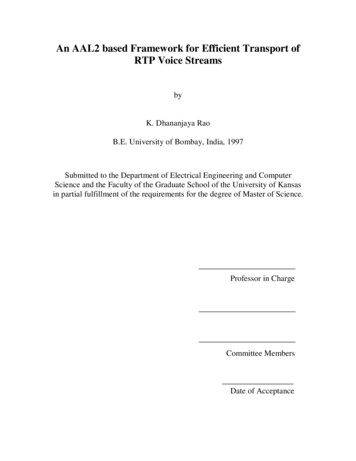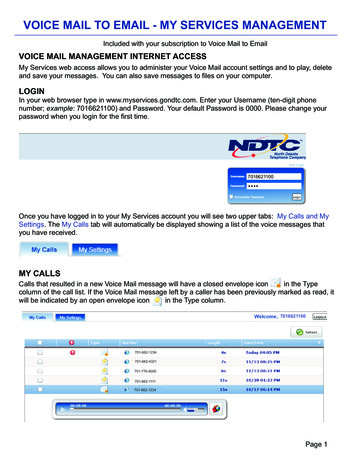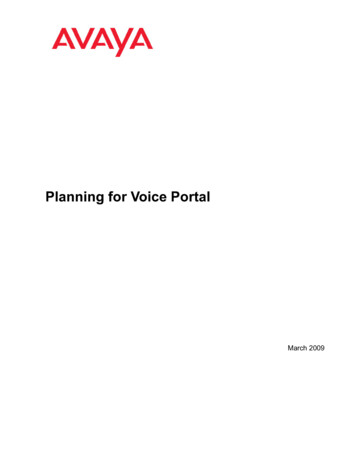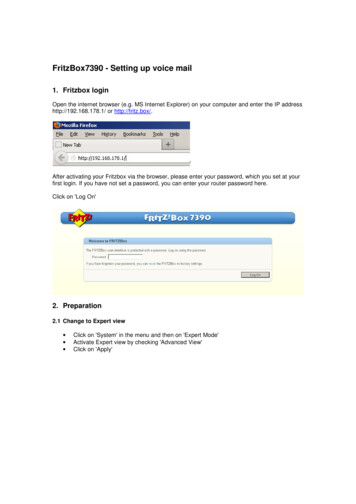
Transcription
Open Voice over IP according to AastraYour connection to the WorldSIP
Innovation, Openness, ConvergenceOver the past few years, Aastra has invested heavily inresearch and development with a view to promoting theconcept of open voice over IP, which comprises solutionsthat are increasingly independent of hardware and arebased on SIP (Session Initiation Protocol).State of the VoIP technologyThe first phase of migration to Voice over IP (VoIP 1.0) wascharacterised by the use of mainly proprietary solutions,without any major impact on existing telephonyarchitectures.Today, with growing IP network reliability and rapid development of newinternet-based communication tools, a second migration phase (VoIP 2.0) hasstarted. It is increasingly based on open standards and reinforces systems,terminals and applications interoperability thanks to the concept of unifiedcommunications.SIP, the key migration factorAastra considers SIP as a catalyst for migration to VoIP 2.0, encouragingend-users to change their analogue and digital terminals to SIP terminals, andfrom TDM operators to SIP operators.In fact, due to the important role played by terminals in VoIP architectures,companies are giving priority to universal terminals that are independent ofinfrastructures and, thus, adapt to technological changes.
But beyond this aspect, SIP enables multimedia applicationsto easily communicate with each other and to choose themost suitable media according to user presence.Thus, thanks to the interoperability offered by SIP, it ispossible to connect video terminals or dual-mode GSM/WiFiterminals to a company’s telephony environment withoutinvesting heavily in new infrastructures.VoIP according to AastraIn the context of convergence towards a unified IPinfrastructure, the need for reliable and scalable solutions isa decisive factor for IT managers when designing theirinformation systems. Aastra provides flexible and scalableSIP-based solutions for between 4 and 150,000 users. Theytake into account problems such as Business RecoveryPlans, with solutions for restart after failure, orencryption-protected communications.Aastra also strives to accompany its customers during thisIP migration by offering innovative solutions as well as a fullrange of professional services aimed at supporting themigration of the existing telephony network to an"intelligent network" capable of managing unifiedcommunications for all departments of a company, thusincreasing its efficiency.
SIP trunkMigration in progress.The number of alternative telephony providers has been growingover the past few years. They use IP technology and SIP to developtheir offers. Traditional providers are gradually following the trend,changing from ISDN to IP links.Today, an increasing number of providers is converging towardsSIP to offer this service: the SIP trunk.Many companies and organisations are already showing interestin this SIP trunking offer which proposes attractive rates whilecontrolling the quality of service and security.SIP offers the basic services required on the network, including:Fully in keeping with its interoperability strategy, Aastra* IPsystems are SIP compatible. This makes it possible to connect SIPterminals, regardless of whether they are standard or advancedterminals, to interface with applications using this same protocol,and to natively use the SIP trunk interface to connect to VoIPproviders. * Visit Aastra’s website for compatible versions.Number displayRestriction of number displayName displayCall forwardingTransfersVoice mail accessThe SIP trunk solution has been tested with major providersand will quickly be adopted by companies, both SMEs withADSL or VDSL connections or large companies.PSTN / ISDN / GSMSIP trunkRouter / BoxVoIP providers
ApplicationsTowards a converging worldAastra’s OfficeSuite, ACP (Aastra Communication Portal) and UCP(Unified Communication Platform) applications evolve alongsidethe standards, at the same rate as the platforms. Therefore, theyhave been naturally designed to work together with SIP terminals.Aastra OfficeSuite is a CTI (computer telephony integration)application that allows calls and voice messages to be managedvia a PC.ACP offers contact center, web attendant, conference bridge andCTI services such as screen pop-up, call recording and intelligentcall-forwarding management via its TWP (Telephony Web Portal)suite.UCP basically offers unified-messaging, automated attendant andpresence-management services.These applications enable a user to monitor and control his orher telephony terminal from the computer application. AastraOfficeSuite, ACP and UCP have been validated with SIPterminals and enable users of such terminals to take fulladvantage of these applications: Participating in a conference call from a SIP terminalScreen pop-up on the PC when the terminal ringsRecording outgoing or incoming callsAccessing the unified messaging system from the SIPterminal Integrating the forwarding status of a SIP terminal, with itspresence status, in the messaging system Use of a SIP terminal by a contact center agent
SIP terminalsIP within reach6751iAastra’s strategy on open standards allows it to support SIPsoftphones on PC or PDA and new SIP telephones.6753iAastra’s range of SIP 6750i terminals, comprising terminals6751i, 6753i, 6755i and 6757i, is meantfor both small and largecompanies. It offers high-qualityIP telephony functions at a competitive cost.Aastra SIP terminals, associated with Aastra systems, allowthe use of a telephony solutioncompatible with the existinginfrastructure, while remaining open to futuredevelopments.6755iBased on the standard SIP, Aastra 6750i terminalsare compatible with a large variety of platforms(example: Asterisk, Broadsoft, etc.).6757i and its expansion moduleStrong points of Aastra 6750i terminals Excellent voice quality Navigation keys which simplify access tothe various functions Voicemail indicator LED The terminals all have a screen, anincoming call log for 200 names, anoutgoing call log for 100 names, or even apersonalised directory for 200 names All the terminals are compatible with a setof XML applications. Users can, thus, haveaccess to standard internet services(example: RSS flows from news sites) aswell as client-specific applications (forinstance: the company’s unified directory) Terminals 6755i and 6757i can haveexpansion modules which allow the use ofadditional programmable keys. Themodules are of two types: paper labels orLCD screen Aastra 6750i terminals are easy to manage,thanks to centralised deployment ofconfiguration files and software updates
DECT over IPCommunicate with complete freedomStrong points of the Open Mobility solution It improves employee mobility It reduces deployment costs:- Common voice/data infrastructure: theDECT base stations are connecteddirectly to the company’s LAN- Wiring is simplified thanks to connectionto the nearest LANThe Open Mobility IP DECT offer combines DECT maturity and performancewith IP flexibility. Aastra thus enables DECT technology users to graduallymigrate to IP, by proposing this IP DECT solution.The solution comprises: Two terminals: OpenPhone 27 and OpenPhone 28Each DECT terminal is considered as an SIP subscriber at the IPBX level.OpenPhone 28 has the Call Device for Isolated Workers function used tomake an automatic emergency call in case of handset verticality loss. Thehandset has equally been reinforced and is compliant with standard IP54(splash and dust resistant). An indoor RFP32IP base station and an outdoor RFP34IP base stationThey are connected directly to the company’s LAN. To ensure handover androaming, the DECT base stations are synchronised via the air interface.These base stations allow 8 simultaneous calls and can be powered overLAN (compatibility with standard 802.3af ). Open Mobility Manager (OMM) softwareThis software manages and handles the processing of IP DECT calls. It iseither installed on a DECT base station or on a dedicated, PC-type Linuxcomputer server.- Base station extension to remote sites:LAN and WAN Traffic density is increased with8 simultaneous communication channels Security is guaranteed throughauthentication and communicationconfidentialityOpenPhone 28OpenPhone 27
WLAN terminalWelcome to the wireless worldStrong points of the Aastra 312w Excellent ergonomicsLarge colour screenHigh battery life (50 h in standby mode, 5 h incommunication mode)SIP compatibilityWide range of telephony functionsEasy deploymentSecure solutionAastra proposes a Voice over Wireless LAN (VoWLAN) offer, whichcan be used together with or as an alternative to integrated DECTand IP DECT solutions.This new solution is SIP-oriented.It is based on standard technologies, completed throughfunctions developed by Aastra in order to offer a morecomprehensive voice-service level.Aastra 312w is a wireless terminal that is compliant with standard802.11b/g. It combines innovative design with voice quality and ahigh functional variety: large back-lit screen, hands-free mode,headset jack, vibracall, etc.A memory card (in SIM format) allows you to back up your privatecontacts, handset personalisation data, network parameters andMAC address. Thus, in the unlikely event you have to replace thehandset, the memory card enables you to transfer the data in thenew phone, without having to enter it again.
Fixed-mobile convergenceThe simplicity of single terminalStrong points of the fixed-mobile convergence solution Single terminalReduced costs of GSM calls: calls in the company pass through the LANand no longer through the GSM networkNo additional software needs to be deployedPossibility to couple the GSM terminal with an Aastra softphone in CTImodeUsers can access a single directory from their terminal companydirectory and private GSM directoryInternational numbers (E164) are accessible via the PBXAastra is entering the fixed-mobile-convergence andsingle-terminal era with the dual-mode GSM/WiFi smartphones.GSM is becoming omnipresent whereas companies are strivingmore and more for cost reduction, time gains and simplicity.Close to 50% of mobile-phone calls made by employees aremade from their office, although less expensive fixed terminalsare at their disposal.In line with Aastra’s strategy of opening up to market standards,Aastra VoIP systems are natively SIP compatible. Users ofGSM/WiFi* smartphones (example: Nokia E6x) can, thus,connect to the enterprise network via this protocol and usealmost all the telephony functions offered by Aastra systems.A dual-mode terminal, declared on the WiFi network andrecognised by the IPBX, offers a variety of functions comparableto that of an enterprise SIP terminal: Speed-dial number management Call log (GSM calls and internal calls) Transfer after call Caller name and number display etc.Thanks to the Aastra SIP interfaces, no modifications need to bemade to the GSM terminal.Thanks to fixed-mobile convergence, communication costs arereduced, and users remain mobile both inside and outside theircompany.* equipped with a SIP battery
APU0018AENAA01Aastra France1 rue Arnold Schoenberg78286 Guyancourt Cedex - FranceTél : 33 (0)1 30 96 42 00Fax : 33 (0)1 30 96 43 00www.aastra.frAastra Telecom United KingdomUnit B3 Armstrong Mall - Southwood Business ParkFarnborough, Hampshire - GU14 0NR - United KingdomTel: 44 (0) 1252 532100Fax: 44(0) 1252 532101www.aastra.co.ukDesign and production: FIRST & 01 30 45 25 78Aastra France - a simplified joint stock company with a capital of 9 561 000 , registered in the Versailles trade register under No. 449.666.36102-08Copyright 2008 Aastra France. Non-contractual document.The data contained in this document is for informationpurpose only and may be modified without prior notification.
Aastra SIP terminals, associated with Aastra systems, allow the use of a telephony solution compatible with the existing infrastructure, while remaining open to future developments. Based on the standar d SIP, Aastra 6750i terminals are compatible with a large variety of platforms (example: Asterisk, Broadsoft, etc.).
